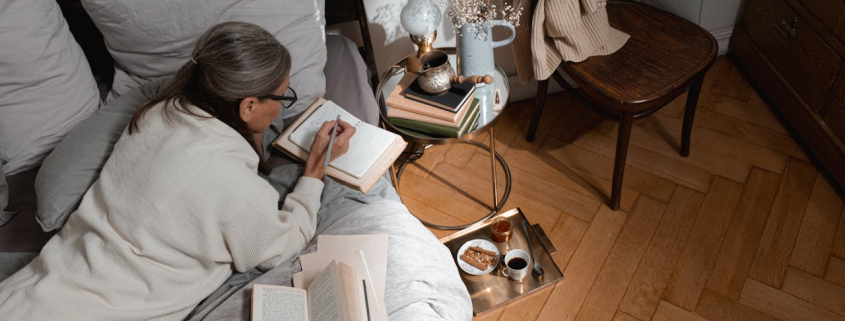One of our 2026 Monarch Award nominees.
Elise realizes it takes her at least ten minutes to pee when she watches an entire interview of her favorite actress on Good Morning America while on the toilet. She can’t remember when it last felt normal to pee. Only that for months she’s been straining, waiting for sweet relief. Elise reads her book on the toilet. Elise brings her laptop to the bathroom and writes emails on the toilet. Elise watches TikToks on the toilet. Elise wonders if she’ll waste her whole life on the toilet, waiting for that last drop of urine to release from her body. It never does. Elise goes to the doctor. She has regular blood pressure, regular BMI, regular everything. Elise is regular. Elise is healthy the doctor says. Elise tells the doctor about her peeing issue. The doctor has her pee in a cup and refers her to a urologist. The pee in a cup test comes back regular.
Elise goes to the urologist who places her hands on Elise’s abdomen and pushes down. Elise doesn’t feel any pain. That’s good, the urologist says. The urologist suggests a small exploratory procedure, a cystoscopy. Elise schedules the follow up procedure.
On the day of the cystoscopy, Elise waits for almost an hour in the waiting room. Elise sweats while she waits. Finally, the nurse calls Elise back to a small room where Elise undresses and puts on a papery light blue hospital gown. When the urologist comes in, she does not apologize for being late. The urologist explains that most women don’t feel any pain with the cystoscopy. Elise nods; Elise is regular, of course, so she should be like most women. Elise grits her teeth. Elise wishes she wasn’t here alone. The urologist doesn’t explain anything else.
The urologist takes a small rod with a camera on its head and forces it up Elise’s urethra. Because most women don’t feel any pain with this procedure, there is no warning when the camera enters Elise. There is no numbing cream. There is no pain medication. Elise is regular. It shouldn’t hurt. But it does. The urologist points to the screen next to Elise. Elise turns to see the inside of her urethra in black and white on the monitor. That’s the inside of me, Elise thinks. The urologist says everything looks regular. There are no obstacles that should cause blockage of urine. But it takes me ten minutes to pee, Elise says. (And really some days it’s twenty minutes). The urologist shrugs and repeats that everything looks regular. The urologist pulls the camera out of Elise’s urethra. Elise flinches as the rod exits her body. What now? Elise asks. The urologist doesn’t have an answer. You’re fine, she says. The urologist exits. Elise doesn’t feel fine.
Six weeks later, Elise receives a letter in the mail. She owes $900 for the cystoscopy. She reads the rest of her mail on the toilet.
Elise’s parents suggest she see their urologist when she comes home for Thanksgiving. He’s the best in the country. He’s a pediatric urologist and Elise is twenty-five. But he’s the number one pediatric urologist in the country her parents insist. Elise’s parents can call him. They know him. He’ll fit her in. Okay, Elise agrees.
The pediatric urologist’s office tells her to show up to her appointment with a full bladder. Elise drinks so much water she worries she may pee herself in the waiting room. Elise can’t stand waiting anymore and she runs to the bathroom. She pees just a little so her bladder will still be full for the pediatric urologist. It is painful to hold on to the rest of her pee, keeping it inside. When she’s called into her appointment, Elise lies on a table in a large room with lights and equipment. A nurse takes an ultrasound of her bladder. Elise looks at the monitor and thinks, that’s the inside of me. The nurse tells Elise everything looks regular. The nurse can see her bladder is very full. Elise is allowed to pee now. Elise pees in a special toilet that measures the strength of her stream. Elise’s stream has never been stronger. She’s been holding her pee for hours. Elise hasn’t peed this hard in months. The nurse says everything looks regular and sends Elise to a second ultrasound.
Elise drinks an entire water bottle before the second ultrasound. This ultrasound is for Elise’s kidneys. Elise told the doctor sometimes she rubs her lower back to try and release her last drops of pee. The doctor wants to make sure her kidneys look regular. Elise lies on her stomach as the nurse takes images of her kidneys. Elise glances up at the monitor. Her kidneys look rather nice up there, she thinks.
Six weeks later, Elise gets on a video call with the pediatric urologist. The pediatric urologist says everything looks regular. Elise’s bladder is regular. Elise’s kidneys are regular. This is good news, surely. Elise feels crushed. The pediatric urologist says because her parents are his good friends he will even waive the fee for this consultation. Gee thanks, Elise thinks. The pediatric urologist says his specialty is pediatrics, which Elise already knew. The pediatric urologist recommends Elise see a gynecologist. Maybe a doctor for adults will know why Elise can’t pee. Elise thanks the pediatric urologist (for nothing) and hangs up.
Elise turns twenty-six. Elise responds to birthday messages on the toilet.
Elise gets dinner with her best friend at an overpriced restaurant. Elise’s best friend is moving in with her boyfriend. Elise tells her congratulations. Elise goes to the bathroom. Elise tries to pee as fast as she can so she can get back to her friend. It takes her eight minutes. When Elise gets back to the table, her best friend asks if she’s okay. Yes, all good. I just have this weird thing where it takes me a long time to pee. Haha. Elise laughs. It’s funny. Elise’s best friend asks Elise if she’s ever heard of pelvic floor therapy. Elise has not.
Elise’s best friend says her boyfriend has the biggest dick of anyone she’s ever slept with. Elise laughs. She doesn’t need to know about the size of her best friend’s boyfriend’s dick. But then Elise’s best friend explains how when they first got together, she had pain during sex. She didn’t know what to do. She knew she was falling in love. Sex was supposed to be wonderful with someone you love. It wasn’t supposed to hurt. Elise’s best friend ended up going to pelvic floor therapy and it really helped. Apparently, a lot of women have pelvic floor issues. Maybe that’s what’s going on with your peeing, Elise’s best friend tells her. Elise thinks her best friend is smarter than the doctor, and the urologist, and even the number one pediatric urologist is the nation.
Elise goes home and looks up pelvic floor therapy. According to the National Institute of Health, one in four women experience pelvic floor disorders. Elise learns a lot of women suffer from urinary incontinence. Elise reads the list of symptoms for urinary incontinence. Some of them sound like her. Some of them don’t. The doctor and the urologist and the pediatric urologist told Elise she was regular. Elise doesn’t know where she fits on the spectrum from regular to incontinent.
The next weekend, Elise goes to her best friend’s housewarming party. Her best friend and her best friend’s boyfriend with the big dick have rented a cozy apartment and decorated it as their own. Elise’s heart is filled with warmth as she watches her best friend’s smile lines deepen all evening. At the party, Elise meets a cute girl with long hair and glasses and a ring between her nostrils. The cute girl was in grad school with Elise’s best friend’s boyfriend with the big dick. The cute girl asks Elise if she wants to go somewhere to hang out. Elise says yes.
The cute girl and Elise go back to Elise’s studio apartment. They smoke a joint and then they make out on Elise’s bed. The cute girl takes off her shirt. Then, the cute girl takes off Elise’s shirt. They tangle together. Elise feels if there was a camera inside her, the monitor would show a glowing, warm fireplace. Her insides all blue and orange and crackling. The cute girl puts her fingers inside Elise’s vagina. Elise tells her to stay out of there. Focus on the top. The cute girl happily obliges and rubs Elise’s clit until she comes. Elise falls asleep with her cheek on the cute girl’s shoulder. The next morning, the cute girl kisses her goodbye.
Six weeks later, the cute girl is Elise’s girlfriend. Elise’s insides are still burning. A happy, exhilarating glow. Elise’s girlfriend sleeps overs at Elise’s studio apartment at least once a week. One night, Elise’s girlfriend asks her why it takes her so long to pee. She’s noticed sometimes Elise disappears for a while when she heads off to the bathroom. Elise explains she has this issue where she can’t pee. But don’t worry, she saw the inside of her urethra, the urologist put a camera up there, and everything is regular. Haha. Elise’s girlfriend says that doesn’t sound regular to her. Is this why Elise doesn’t like her fingers inside of her? Elise shrinks in shame. She wishes she did. But anything inside of her hurts. Elise’s girlfriend hugs Elise. Elise’s girlfriend says it sounds like the urologist doesn’t know what she’s talking about. Elise says, I love you. Elise’s girlfriend says it back.
Six weeks later, Elise has an annual physical with a new doctor. Elise is twenty-six now and has her own insurance plan separate from her parents. Elise tells the new doctor about her peeing issue. The new doctor has seen the previous tests and ultrasounds Elise has done. I know everything looks regular, but it’s not, Elise says. Elise tells the new doctor she needs pelvic floor physical therapy. The new doctor writes her a prescription for a physical therapist. [Continued inside Vol.5]
ALANA ROSENBLOOM (she/they) is a writer, poet, filmmaker, and choreographer. In their work, she ponders queerness, identity, love, grief and the tumultuous nature of growing up. They were most recently a writers’ assistant for Liz Feldman’s new Netflix show No Good Deed. Throughout her career she has gotten coffee for and worked in writers rooms with acclaimed comedians, such as, Mel Brooks, Mindy Kaling, Jason Mantzoukas, Nick Kroll, Ike Barinholtz, and Wanda Sykes. Alana attended Northwestern University where they received their BA in Radio/Television/Film with a focus on screenwriting and a minor in dance. She currently resides in Los Angeles with her fiancé and little chihuahua, Franklin.
Love it?
Alana’s work is in Vol.4. Consider subscribing to support Anodyne Magazine and its contributors. We pay our contributors dividends for each purchase! Plus, this is the only place you’ll find an ebook + print subscription combo.






